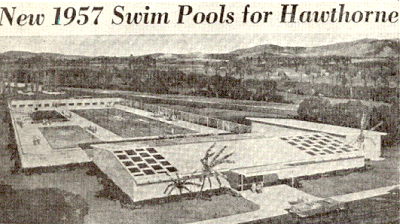The History of Hawthorne by Robert S. Hartman
In 1957, with the aid of the County Board of Supervisors, a $300,000 municipal swimming pool was dedicated. Located on the grounds of the Hawthorne High School, the facility consists of a main pool, a diving pool, and an instruction pool.

In 1962 the first modern regional library was established with a total book collection claimed to be the second largest in the county, with the exception of downtown Los Angeles. The main library is located at 12700 South Grevillea, the Holly Park Library is at 2150 South Inglewood Avenue. These three facilities have 250,000 volumes in stock and circulate over 600,000 volumes annually.
Growing from a little village of a few acres, Hawthorne, in 1973, plays an important role in the economy of Southern California. Its boundaries have been extended many times to a size of over five square miles.
There has been 138 successful annexations to the City of Hawthorne since incorporation. These annexations have added 3.56 square miles to our city's boundaries and 2,300 acres. At incorporation in 1922, our acreage was 1,248 (now 3,559.11) and our square mileage was 2 (now 5.56). Although the majority of the annexations were small strips and acres required to straighten out boundaries, a dozen or more were large acquisitions of 100 to 250 acres. Vacant land annexed totals over 1500 acres for development, but most of the annexations were inhabited and these added several thousand residents to our tax rolls and our population. We have had some annexation failures of course, but in the majority of cases the people have noted their preference to be a citizen of Hawthorne, the "City of Good Neighbors."
The elementary school district consists of 9 schools, 255 teachers, 5,300 pupils, and facilities valued at $8 million. The operating budget exceeds $3.5 million; in 1942 the budget was $167,000.
Average property tax comparisons indicate Hawthorne's 1972 rate of $11.26 per hundred is the lowest of the surrounding cities in the Centinela Valley. This is due in great part to the consistent reduction of city taxes from $1.70 per hundred in 1942 to 72 cents in 1972.
The 1970 census gave Hawthorne a population of 55,000, an increase of 53,000 in fifty years. 31% of our population has lived in Hawthorne over 15 years, 41% five to ten years, and 21% one to five years. The ages of our population show 23% less than nine years old, 15% ten to nineteen, 14% twenty to twenty-nine, 32% thirty to thirty-nine, and 15% over fifty. At incorporation in 1922, there were 703 dwelling units; there are now over 20,000.
Recollections | Reunions | Street Scene | Teachers | Tributes | Vietnam | What's New | Keyword Search